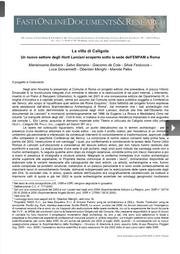Buy this book

The excavation involved a new sector of the Horti Lamiani, gardens of exceptional historic-topographical importance. Originally the property of the consul L. Aelius Lamia, they became imperial property perhaps as early as the reign of Tiberius (14-37 A.D.) and were then acquired by Caligula who established his residence there.
In the past the site has been the theatre of important archaeological and antiquarian discoveries (for example the Esquiline Venus, the bust of Commodus and the Ephedrismòs in the Capitoline Museum, the Lancellotti Discobolus in the Museo Nazionale Romano, the statues from the bath complex in via Ariosto at the Centrale Montemartini), most of which came to light at the end of the 19th century during work on the construction of the new Esquiline residential quarter. A number of nuclei belonging to the imperial property were hastily documented but then sacrificed to the need to build.
The excavation uncovered an area of the Horti Lamiani unknown to date, close to the area where Lanciani (Fascino di Roma Antica: 155-157) had documented a long cryptoporticus with an alabaster floor and precious wall decorations, divided by columns of giallo antico with gilded stucco bases, decoration which finds confirmation in the ancient sources (PHILO. IUD., Leg. Ad Gaium 351 ss.). Further finds were registered during work on the modernisation of the Metro A in the south quadrant of the gardens in Piazza Vittorio, between January 2005 and November 2006 (Barrano, Colli, Martines in www.fastionline.org/docs/FOLDER-it-2007-87.pdf).
The new sector found below the ENPAM building was centred around a reception hall (400 mq), originally faced with sectilia, with service rooms and a fountain (shown in the FUR fig. 24 together with two of the three connected rooms). The complex comprised garden-terraces contained by opus reticulatum structures, with a stretch of basalt paved road connected to the via Labicana, perhaps the property’s boundary.
The hall can be attributed to interventions by Severus Alexander (222-235 A.D.), also attested on the Esquiline by the construction of the “Trophies of Marius” and a number of fistulae aquariae (e.g. CIL XV, 7333) proving the existence of a complex belonging to the emperor’s personal patrimony. Hundreds of fragments of refined painted wall plaster and other precious decorative materials, datable from the start of the construction of the imperial residence onwards, were recovered during the excavation. The discovery of decorative marble elements identical to those found in the 19th century (now in the Capitoline Museum) suggests that the new sector may link to the complex discovered by Lanciani.
The earliest levels are those of the villa’s construction and, even earlier, the Esquiline necropolis, still to be investigated, but attested by the literary sources and in the modern era by G. Pinza (Mariarosaria Barbera, Oberdan Menghi, Manola Pales).
Buy this book

Places
Horti Lamiani, Horti Maiani, Horti MaecenatisTimes
Roman antiquityShowing 1 featured edition. View all 1 editions?
| Edition | Availability |
|---|---|
|
1
La villa di Caligola: Un nuovo settore degli Horti Lamiani scoperto sotto la sede dell'ENPAM a Roma
2010, Fasti on line - AIAC (Associazione Internazionale di Archeologia Classica)
Essay
in Italian
|
aaaa
|
Book Details
Published in
Roma, Italia
Table of Contents
Edition Notes
Contributors
The Physical Object
ID Numbers
Links outside Open Library
Community Reviews (0)
Feedback?| January 13, 2017 | Edited by Oberdan Menghi | Edited without comment. |
| February 3, 2014 | Edited by Oberdan Menghi | Edited without comment. |
| July 13, 2011 | Edited by Oberdan Menghi | Edited without comment. |
| October 6, 2010 | Edited by Oberdan Menghi | links |
| August 12, 2010 | Created by Oberdan Menghi | Created new work record. |









